Ciao, readers! I am the National Wine Educator of the Month for the Society of Wine Educators. The Society is posting a series of my articles, pertaining to wine educators – but if you ask me, there are gems in there for everyone to enjoy. This week’s article is about the many benefits (for educator and client alike) of incorporating the local wine scene into wine education activities. So get in the car and explore your territory! Here is the article link.
Adventures, reviews, tips and experiences relating to travel but not directly to food, wine, or other categories.
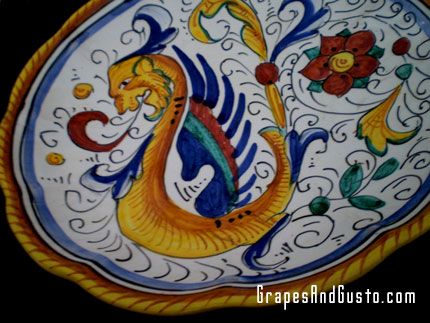
This lively, stylized dragon is a signature mark on the classic Raffaellesco pattern used on many Deruta majolica pieces. Pictured here is a plate from my personal collection.
Who am I to judge those who obsess over the dining chairs of an obscure designer, or those deranged fans of discontinued lipstick shades, hunting down the last remaining world supply with cold-sweat fervor? Not I. I will readily own up to my own unique brand of fascination: Italian majolica (pronounced “maYOLica”, and sometimes spelled maiolica). Majolica is pottery painted in a protected Renaissance tradition in the town of Deruta, in the region of Umbria. For those cooking-lesson villa renters out there, and fans of “Under the Tuscan Sun,” you may know Umbria as the region just southeast of Tuscany.
But Deruta pottery is so much more than some hand-painted flourishes scrawled on a fruit bowl. Deruta pottery comes in a variety of historic designs, which I will point out shortly. But aside from the rich tradition surrounding Deruta wares, I make the audacious claim that a Deruta dinner plate changed my life.
A dinner plate?
Yes – and from an early age, too. As a child, I used to play at the home of our family friends where I discovered an untapped passion. This couple has led tours to Italy for many years, particularly based around the Renaissance capital of Florence. In their home, I grew up gazing at the large, glamorous photos of them standing proudly in front of medieval architecture, and with wind-blown smiles atop city panoramas. Dressed in stylish gear, gelato in hand, they posed on gondolas and beside clock towers. I loved being in their home, surrounded by volumes of glossy art books, and the cozy luxury of rugs and artwork in every cranny.
But perhaps most of all, it was their elegant, stylish dinner parties (viewed from my vantage point at the “kids’ table”) that intrigued me the most. This is where I witnessed their never-ending parade of Deruta pottery: ceramic candlesticks whose colorful designs glowed amid the din of group laughter; platters sturdy enough to hold plump piles of veal piccata and hearty helpings of pesto linguine, and yet charming and poised enough to grace a table fit for Company.
Damn the kids’ table, I thought, as I gazed at my hot dogs n’ beans.
It was during one of these entertaining affairs that I first saw it: Raffaellesco, the pattern of my dreams.
Lively, stylized dragons with tapering tails in rich shades of golden maize, accented with cobalt, brown and teal. More ornamentation than a Bach fugue, but it all worked cleanly against the crisp, white background. This is truly the spirit of the Renaissance, captured perfectly! I remember thinking, as I reached the flashpoint of my lifelong love of the Italian Renaissance.
The Raffaellesco pattern offers an experience both visually and energetically. It is regal and stately, yet fun and dynamic – a satisfying combination for those with modern formal tastes.

In this detail from an authentic Deruta plate, you can see the brushstrokes indicating true, hand-painted workmanship.
The name Raffaellesco is attributed to the Renaissance artist Raphael, who was thought to have painted a benevolent sea god meant to protect seafaring merchants on their journeys. The design stuck, as it is one of Deruta’s most famed and popular designs. Other classic Deruta designs include the colorful Ricco Deruta, considered the oldest and most traditional pattern in the Deruta tradition; Orvieto, a nod to rustic living with its cheerful, green roosters; Siena, an elegant, black-bordered collection featuring medieval-style flora and fauna; and the lively Arrabesco pattern, featuring birds and freeform decorations that evoke a more contemporary sensibility.
The town of Deruta takes its pottery traditions very seriously. The city houses what is widely considered the world’s foremost authority for the teaching of the Deruta majolica technique, the International School of Ceramic Art “Romero Ranieri.” All authentically created, local majolica pieces contain a special “Deruta” signature on their underside, usually hand-painted rather than stamped. The producers must follow strict design guidelines if they are to label their majolica pieces in the classic series. This handiwork does not come cheap, and even within the regulated producers, there is a spectrum of quality and refinement. For the real deal, expect to pay at least $100 for a dinner plate (yes, one dinner plate).
Recently, after a two year investigation, the Italian police uncovered a Deruta fraud ring. According to a March 10, 2010 article published at ThatsArte.com’s blog by Tiziana, “last February…Italian police charged the owners of three companies located in Assisi and Deruta with fraud and other administrative crimes. They manufactured fake Raffaellesco and Ricco Deruta pottery that was then partly sold to bus loads of unaware tourists visiting Assisi, partly exported to Europe, Japan and to the US at competitive prices.” The police seized over 2000 pieces that bore the coveted “Handpainted in Deruta” signature but which were actually decal transfer work.
The dramatic world of art fraud is far-reaching, I’m afraid. I have encountered several knock-offs in some of my own local home furnishing stores. It is easy to spot these knock-offs if you look closely. You will be able to see a tiny “dot matrix” printing texture instead of a smooth series of brushstrokes. To this, they will often hand-paint the rim of the plate which may add more of an authentic look to the unsuspecting eye. Sure, these are priced quite inexpensively, but like first-class air travel, once you’ve experienced the real deal, it’s hard to go back.

This hand-signed mark on the underside of a Deruta majolica piece indicates authenticity.
Not surprisingly, I ended up spending a blissful semester in Florence during my college days. I was thrilled when I found an affordable Deruta (or was I duped into buying “Deruta style”?) vendor stand in one of the piazzas. I bought a small Raffaellesco plate, but it then broke in transit back to the States. Since then, I have thirsted for more Deruta to ease that early disappointment. But a funny thing happens with these types of pursuits. Suddenly, one piece is no longer enough. The most insidious part of a “Deruta-ddiction” is that these beautiful pieces are also functional. The rationalizations can get out of hand. I mean, who couldn’t use a mezzaluna (crescent-shaped) cookie dish around the house, or a hand-painted biscotti jar to catch someone’s hands in?
Come on, you know you want a rooster-shaped pitcher.
To purchase Italian majolica in the U.S., visit the website of Biordi in San Francisco, California. There are many other purveyors of Italian majolica in the U.S., but Biordi carries some of the finest examples of majolica from Deruta and other regions. Their inventory spans from classic to more contemporary styles, and many items beyond tableware. You can even commission your own designs through them.
© Gilat Ben-Dor, 2010. All rights reserved.
Tags: art, Entertaining, Italy, passion, Tableware

Velvety jewel: A tall glass of fresh-squeezed pomegranate juice at Cafe Neto in Tel Aviv's Dizengoff Center.
I am quite a pomegranate aficionado: an admirer of their whimsical shape, their seductive ruby seeds, and the rich symbolism they hold, from fertility to happiness. In the United States, POM and other brands compete on the market to offer concentrated pomegranate juice, but during a recent trip to Israel, nothing beat the fresh squeezed varieties being offered in stands and cafés. If you know what pomegranate seeds are like — fairly dry to the touch with a delicate glaze encasing each seed — you could appreciate how many pomegranates it would take to concoct a big, tall glass of straight, anti-oxidant-rich, tart and tasty juice. And the color? Worthy of artistic inspiration. In Israel, they were certainly fond of their juice bars, but the crowning glory was the wide availability of this crowned, ancient fruit.
Beyond drinking pomegranate juice straight (or in cocktails), sprinkling the tangy seeds on a salad, or making a reduction of its juice to sauce meat with, what are other ways to incorporate pomegranates into cooking? Feel free to add your comments. I am convinced this will not be the last of a posting on pomegranates.
© Gilat Ben-Dor, 2010.
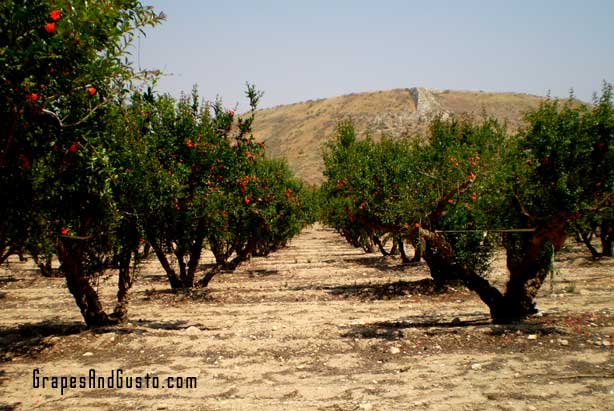
Pomegranates do grow on trees. The grove seen here is a common sight near the village of Lachish in Israel.
Tags: Israel, pomegranates, Travel Adventures, wellness
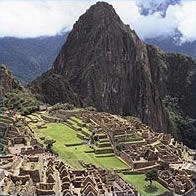 Attention, bloggers, winos and foodies!
Attention, bloggers, winos and foodies!
Ever wanted to explore Peru’s legendary Inca Trail, at an elevation of 13,000 feet…with gourmet food and wine being cooked for you along the way? Of course you do! Firestone Wines is pairing up with Zephyr Adventures to send a small group, including a paid food and wine blogger, on an exotic Inca Trail hike in Peru. This lucky winner, dubbed the Firestone Wines Discoveries Pathfinder and chosen through a special contest, will receive an all-expense-paid trip, including airfare to Peru, between April 17-25, 2010, plus a $1,000 stipend. Click here for contest rules.
But wait – there’s more! There is also another winner spot for the chosen chef on the trail. See details about the Chef Challenge here.
Peru is you, baby!
Tags: Contests, Travel Adventures

Ancient artifacts are displayed amid the sleek modernity of Israel's Lod Airport.
Israel’s Lod International Airport, just outside of Tel Aviv, boasts a light, airy and spacious interior, and my favorite touch: actual ancient artifacts displayed throughout the walkway area. It is always fascinating to see the old and the new merged together – going much further back than the Louvre’s “old/new” addition of the glass structure, and even older than the Medieval buildings of Florence being used as gelato bars.
Being juxtaposed with truly ancient artifacts can, at once, make us feel like we, too, are just ‘passing through,’ dwarfing our own existence. At the same time, there is something continual and relevant about this coexistence, reminding us that there are still many things that stand the test of time, of history, and of cultural preservation. Our spirit and energy guarantee that we are not nearly as flimsy as our fleeting, physical lives would have us believe. And that is uplifting.
© Gilat Ben-Dor. All rights reserved.
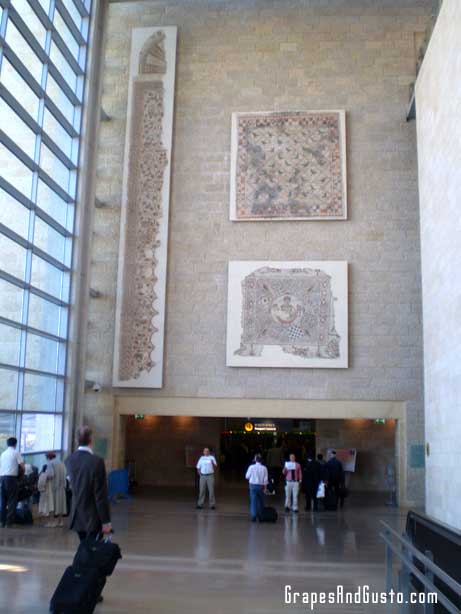
A special energy exists in a land that is so ancient, its decor is comprised of local archaeological finds.
Tags: art, Israel, Travel Adventures
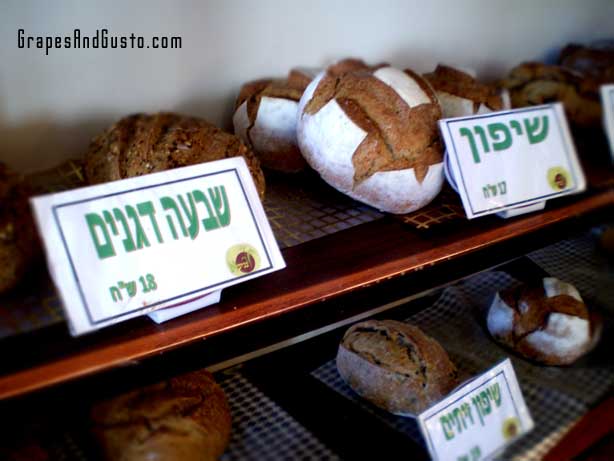
Boutique L’chamim ("Bread Boutique") in northern Tel Aviv offers a tempting array of goody-encrusted breads.
Organic bread. How warm and fuzzy. Just those words, organic bread, invoke images of crusty, chewy loaves that could scratch your face but are so delicious, especially when hot from the oven. These dreamy loaves would also be infused with highly unusual ingredients, lovingly prepared by a gentle artisan who likely favors handmade sweaters and vintage note cards. “Hi there!” they would cheerfully greet me as I walk into their fragrant bakery, feeling the need to hide my BlackBerry and other worldly trappings.
“Care for some lavender oat spelt bread? And a bedtime story?” Perhaps my imagination has taken over (yet again), but I do enjoy the idea of a natural, accidental sort of delicacy – the cool gourmet that wasn’t even trying – through its sheer simplicity of preparation.
And rightfully so. Who wouldn’t want their bread free of chemicals, pesticides, or other extra processing elements that diminish its otherwise grainy goodness? But…here’s the million-dollar question: Could you tell whether you were eating organic versus “regular” bread if there was no fancy sign about it? We could put this to the test by having bakers participate in a blind tasting. Would they be stumped? If not, what would be the distinguishing feature that would whisper organic to their palates?
I am still on my Israel kick from a recent trip there. If you happen to visit or live in Tel Aviv and are seeking organic breads, Boutique L’chamim (Bread Boutique) is your answer. It is a pleasant walk away from the milestone Even G’virol Street. The Boutique sells a variety of breads and sweet baked goods, as well as a collection of jams, spreads and tapenades. Organic or not, I am partial to breads with suspended “stuff” in them (walnuts, olives, sun-dried tomatoes…). Now think back. What is the most unique bread you’ve ever tasted?
And, if blindfolded, could you distinguish between organic and non-organic bread?
© Gilat Ben-Dor. All rights reserved.
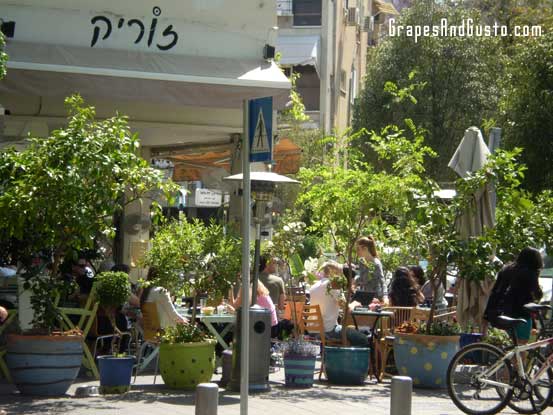
The lunch rush feels like a leisurely gathering in northern Tel Aviv's hip cafe, Zurich.
On a recent trip to Israel, it was hard to miss the fact that Tel Aviv, along with most of Israel’s cities, thrives on the energy and hub of the café. Quite similar to Europe, in fact. Unlike the Starbucks institution we know (all too well) back in the States, Israel’s cafés seem to have a different kind of energy.
First, the cafés tend to focus on being outdoors, being part of a scene, of seeing and being scene – though with a surprising lack of pretension. While there were some laptoppers I observed in the Tel Aviv cafés, it seemed that most of the caférati were there to be in the moment – to socialize, or if alone, to take in their surroundings over an “upside down coffee” (kafe hafuch), a popular way to have your brew, with the coffee sprinkled over hot milk rather than having water poured onto the coffee first. Also, while there are several café chains in Israel now – Aroma, Café Hillel, CafeCafe, Arcaffe – there still seemed to be a very individual spirit to each café, and plenty of independent locations.
Another note on Israeli cafes is that they focus on food well beyond the carb-laden, glass case offerings. You can often order a typical Israeli breakfast which includes tomato and cucumber salads chopped into painstakingly tiny pieces, with lemon and olive oil, as well as eggs, cheeses, and breads or even sandwiches. “Real” food for breakfast, if you will; perfect for the savory protein lover, like yours truly.
© Gilat Ben-Dor. All rights reserved.
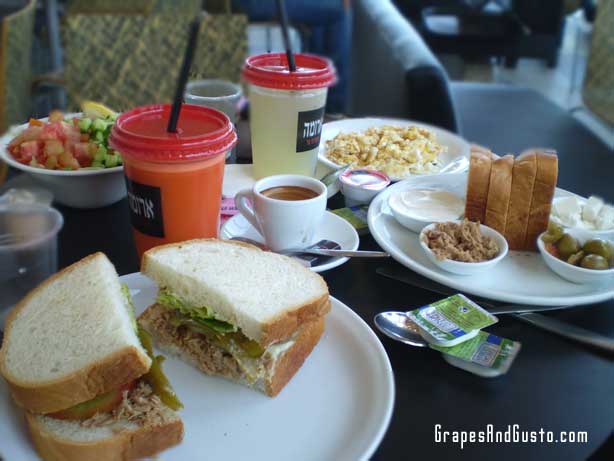
Typical breakfast fare at an Israeli cafe includes fresh, chopped salads, eggs, fresh-squeezed juices and sandwiches.
Tags: Israel, Restaurants, Travel Adventures

Bar Avion, at New York's JFK airport, proves that preparing for take-off can feel mod and stylish.
Stale smoke, sticky floors, and the guy camped out ordering four double Long Island Iced Teas in plastic cups may be a thing of the past – or at least, a thing that does not plague all bars. Bar Avion, in New York’s JFK airport (Terminal 4) is bringing the swizzle back in the stick with its mod-meets-European design in calming blue tones. And don’t forget the actual food displayed at the door – a Japanese influence, perhaps? Bar Avion is a great example of the stylish way to prepare for take-off.
Does anyone have another example of a not-too-shabby airport bar?
© Gilat Ben-Dor. All rights reserved.
Tags: spirits, Travel Adventures
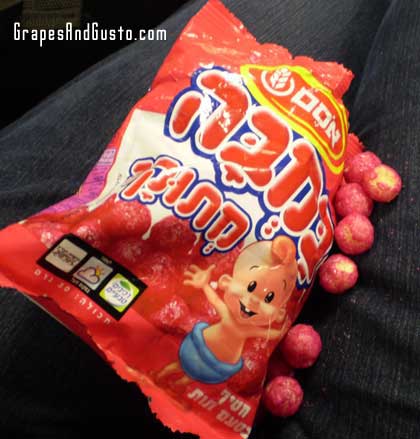
Sweet Bamba, the strawberry-flavored Israeli snack, makes for an interesting wine pairing challenge.
One of my sweet childhood memories, literally, involves a snack made in Israel: crunchy, festive little magenta spheres, strawberry flavored and known as “sweet Bamba” (as opposed to their original, burnt-orange colored, peanut-flavored counterpart, just known as “Bamba”). Given that a dessert should never be sweeter than a wine that it’s paired with (lest it make the wine taste bland or bitter), I’m curious as to pairing a ripe, honeyed Sauternes or Barsac with good ol’ strawberry Bamba.
If anyone beats me to this, let me know the results…or at least, your predictions.
© Gilat Ben-Dor.
Tags: Food, Israel, Travel Adventures
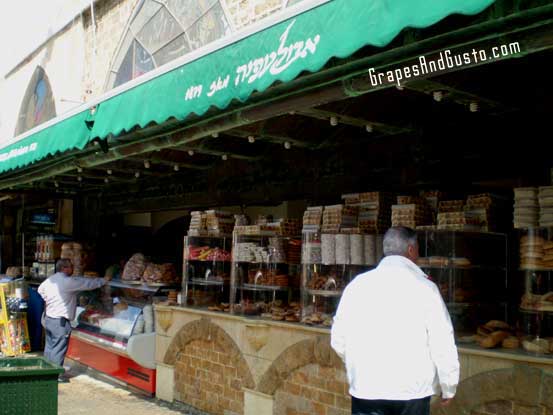
Abulafia, the bakery that has become an institution in the Tel Aviv/Jaffa (Yafo) area.
What makes a place an “institution”? No, not those kinds of institutions with straight jackets, mind you, but those places like Katz’s Deli in New York or Barnacle Billy’s in Maine. What makes a place elicit repeat business and a certain comfy notoriety? The predictable answer may be the combination of good food, hearty portions (that’s comfy!), warm service and a historic bent to the place. Add to that some childhood memories, and you’ve got the formula for a landmark locale.
Take Abulafia, the Jaffa-based boulangerie in Israel. They have expanded locations and gotten somewhat more slick in their distribution of their beigaleh and other savory baked treats, yet on a recent visit to Israel, after 18 years away, a funny thing happened to me. I did not necessarily recognize the original building (was it there in ’91?) but rather, I remembered what I used to order as a child from there…and had to get another. Take it all in: the flavorful sautée of onions, mushrooms, and yes, egg, all on a base of their hearty white beigaleh. It was nice to be back.
© Gilat Ben-Dor.

Abulafia's onion and egg bread: After 18 years away, it's nice to return and order an old favorite.
Tags: bread, Food, Israel, review, Travel Adventures
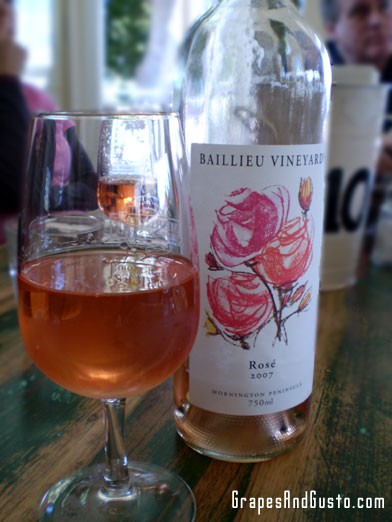
Australia's Baillieu Vineyards Rose is both pretty and versatile, though may be hard to come by stateside.
If Barbie dolls drank wine, they might pick this stylish label to match their sun dresses (Summer Sipping Barbie, anyone?). But as for the contents inside the bottle, au contraire, mon frere. Festive, airy, and refreshing, Baillieu Vineyard’s 2007 Rosé is made from the Pinot Noir and Pinot Meunier grapes (of Champagne-region fame), gently pressed into a crisp, fragrant sensation. The color is beautiful, and so is the versatility. Pair this with pasta primavera, grilled vegetables, or as I did, a generous piece of veal, simply prepared in a schnitzel style with an herbed vegetable mélange. This is a dry wine with a faint sweetness on the nose reminiscent of strawberries smeared onto rainy mineral stones.
The setting in which I experienced this wine made this wine that much more of an experience – the charming Merricks General Store in the Mornington Peninsula, in Victoria, Australia. This historic outpost, once an actual general store back in the 1920s, now boasts an impressive city-grade menu, in multiple versions. Its Cellar Room menu boasts interesting charcuterie items such as Barossa chicken liver parfait, ocean trout rillettes, and herbed labna balls (a nod to the Middle Eastern cheese-style yogurt spread), as well as cozy vittles like hearty soups and crusty breads. Its Dining Room menu features thoughtful starters like crème frâiche and gorgonzola pannacotta with prosciutto and honey cardamon roasted figs, and entrées such as beetroot gnocchi with mushrooms, walnuts, gorgonzola cheese and fried sage; and saffron and leek risotto with swimmer crab meat and cured ocean trout. (Breakfast/brunch is also available).
Clearly, this former supply outpost has evolved with a playful sophistication that’s a surprising treat for its rustic roots. Merricks General Store (apparently no apostrophe) is also the showcase restaurant for three collections of wine: those of Elgee Park, Mornington Peninsula’s oldest winery; Quealy, featuring winemaker Kathleen Quealy in conjunction with Balnarring Vineyard, and including some interesting blends, like the white Pobblebonk Italian blend, and Rageous, an unusual red blend of Shiraz, Pinot Noir and Merlot; and of course, Baillieu Vineyards, featuring our esteemed rosé and others, all featuring those pretty labels by artist Julie Johnston. Wine, art, and the delicious pastime of hanging out at a charming foodie general store. No complaints.
Does anyone have an unusual gem of a rosé to share with us?
© Gilat Ben-Dor.
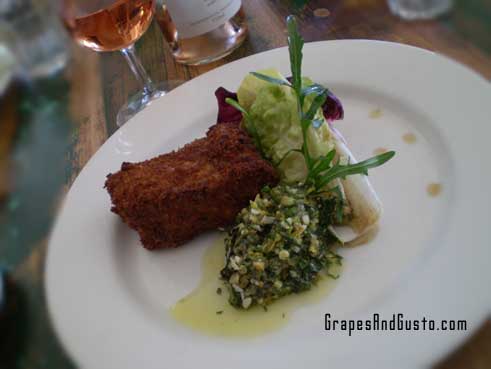
Proof of rosé's versatility: from pasta to vegetables to schnitzelled veal in a single bound.
Tags: Australia, Restaurants, summer, Wine



Recent comments